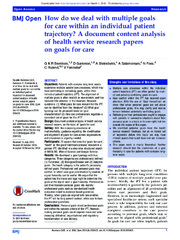| dc.contributor.author | Berntsen, Gro Karine Rosvold | |
| dc.contributor.author | Gammon, Barbara Deede | |
| dc.contributor.author | Steinsbekk, Aslak | |
| dc.contributor.author | Salamonsen, Anita | |
| dc.contributor.author | Foss, Nina | |
| dc.contributor.author | Ruland, Cornelia | |
| dc.contributor.author | Fønnebø, Vinjar | |
| dc.date.accessioned | 2016-03-14T07:38:02Z | |
| dc.date.available | 2016-03-14T07:38:02Z | |
| dc.date.issued | 2015-12-10 | |
| dc.description.abstract | Objectives: Patients with complex long-term needs
experience multiple parallel care processes, which may
have conflicting or competing goals, within their
individual patient trajectory (iPT). The alignment of
multiple goals is often implicit or non-existent, and has
received little attention in the literature. Research
questions: (1) What goals for care relevant for the iPT
can be identified from the literature? (2) What goal
typology can be proposed based on goal
characteristics? (3) How can professionals negotiate a
consistent set of goals for the iPT?
<p>Design: Document content analysis of health service
research papers, on the topic of ‘goals for care’.
<p>Setting: With the increasing prevalence of
multimorbidity, guidance regarding the identification
and alignment of goals for care across organisations
and disciplines is urgently needed.
<p>Participants: 70 papers that describe ‘goals for care’,
‘health’ or ‘the good healthcare process’ relevant to a
general iPT, identified in a step-wise structured search
of MEDLINE, Web of Science and Google Scholar.
<p>Results: We developed a goal typology with four
categories. Three categories are professionally defined:
(1) Functional, (2) Biological/Disease and (3) Adaptive
goals. The fourth category is the patient’s personally
defined goals. Professional and personal goals may
conflict, in which case goal prioritisation by creation of
a goal hierarchy can be useful. We argue that the
patient has the moral and legal right to determine the
goals at the top of such a goal hierarchy. Professionals
can then translate personal goals into realistic
professional goals such as standardised health
outcomes linked to evidence-based guidelines.
Thereby, when goals are aligned with one another,
the iPT will be truly patient centred, while care follows
professional guidelines.
<p>Conclusions: Personal goals direct professional goals
and define the success criteria of the iPT. However,
making personal goals count requires brave and widesweeping
attitudinal, organisational and regulatory
transformation of care delivery. | en_US |
| dc.description | Published version, also available at <a href=http://dx.doi.org/10.1136/bmjopen-2015-009403>http://dx.doi.org/10.1136/bmjopen-2015-009403</a> | en_US |
| dc.identifier.citation | BMJ Open 2015, 5(12):1-8 | en_US |
| dc.identifier.cristinID | FRIDAID 1312173 | |
| dc.identifier.doi | 10.1136/bmjopen-2015-009403 | |
| dc.identifier.issn | 2044-6055 | |
| dc.identifier.uri | https://hdl.handle.net/10037/8905 | |
| dc.identifier.urn | URN:NBN:no-uit_munin_8495 | |
| dc.language.iso | eng | en_US |
| dc.publisher | BMJ Publishing Group | en_US |
| dc.relation.uri | http://bmjopen.bmj.com/content/5/12/e009403.full.pdf+html | |
| dc.rights.accessRights | openAccess | |
| dc.subject | VDP::Medisinske Fag: 700::Helsefag: 800::Helsetjeneste- og helseadministrasjonsforskning: 806 | en_US |
| dc.subject | VDP::Medical disciplines: 700::Health sciences: 800::Health service and health administration research: 806 | en_US |
| dc.title | How do we deal with multiple goals for care within an individual patient trajectory? A document content analysis of health service research papers on goals for care | en_US |
| dc.type | Journal article | en_US |
| dc.type | Tidsskriftartikkel | en_US |
| dc.type | Peer reviewed | en_US |


 English
English norsk
norsk